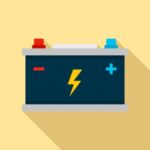This multi-part blog series breaks down a vehicle’s electrical system into easy-to-understand chunks. Part 1 was an overview of the basic principles of auto electrical systems. In Part 2, we will discuss the 3 main auto electrical systems and...
 This multi-part blog series breaks down a vehicle’s electrical system into easy-to-understand chunks. Part 1 was an overview of the basic principles of auto electrical systems. In Part 2, we will discuss the 3 main auto electrical systems and circuits, including the ignition & starter, auto lights, and auxiliary systems. We will cover how these components work, troubleshoot common issues, and discuss repairs & maintenance.
This multi-part blog series breaks down a vehicle’s electrical system into easy-to-understand chunks. Part 1 was an overview of the basic principles of auto electrical systems. In Part 2, we will discuss the 3 main auto electrical systems and circuits, including the ignition & starter, auto lights, and auxiliary systems. We will cover how these components work, troubleshoot common issues, and discuss repairs & maintenance.
How Auto Electrical Systems Work
It may seem like magic, but all your car’s cool features actually work through a complicated wiring network. A vehicle wiring harness is the main body of an auto electrical system. It is a group of wires designed to safely and efficiently deliver electricity from the car battery to devices throughout the entire automobile.
How Auto Electrical Circuits Work
Every electric-powered component in your vehicle works because of an electrical circuit. Electrical circuits are circular routes that electrical currents (aka electrons) flow through. The electrical current / electrons originates from the power source (+ battery terminal) and moves through the fuse. Next, the current flows to the switch and into the load device, like your headlights. Then, the current goes through a ground wire secured to the vehicle’s frame. Finally, the current completes its loop back to the power source (- battery terminal).
3 Main Auto Electrical Systems In Combustion Engines
Now that we know more about how auto electrical systems & circuits work let’s look at 3 main areas that use electricity.
Starting & Ignition System
The starting system of internal combustion engines needs to convert electrical-energy from the car battery into mechanical-energy. The ignition system utilizes both electrical and mechanical components. Basically, the starter solenoid, which is an electromagnet that controls the electrical current from the battery turns on the starter motor.
Once the engine has started, the starter motor no longer relies on the car battery to run. Instead, the alternator produces Alternating Current (AC), which powers your vehicle’s electrical systems while the engine is running. Additionally, the alternator converts AC power to Direct Current (DC) and then stores it in the vehicle’s battery to maintain a full charge.
Auto Lights
Lighting circuits power your vehicle’s auto lights through connections to the car battery. Generally, vehicle lights are wired in parallel (vs. in-series) to provide each light with the right amount of current. Check your vehicle’s owner’s manual for the wiring diagram for your specific make & model. Bare in mind that your automobile’s lighting system is an essential tool for your safety and includes:
Headlights (High-Beam, Low Beam, Fog) Taillights Brake Lights Back-up Lights (Reverse) Blinkers or Turn Indicators Hazard Lights Running Lights Interior Lights (Cabin Lighting)Auxiliary Systems
Auxiliary Systems are the electrical components that control all the nifty bells & whistles in your vehicle. They may include:
Alarm & Security Systems (Automatic Door Locks, Anti-Theft System, Horn) Comfort Systems (Adjustable & Heated Seats, HVAC, Sunroof, Window Controls) Information Systems (GPS, Instrument Panel, In-car Entertainment, On-Board Computer, Trip Recorder) Safety Systems (Side Mirrors, Windshield Wipers & Windshield Fluid Nozzle)Many of these components are wired to operate whether the car is running or turned off. Fortunately, most of these components draw very little power from the car battery. However, to avoid draining your battery, limit the use of the entertainment systems while the car is not running.
Issues & Troubleshooting
The electrical systems & circuits in your vehicle are complex, and issues can happen at any point. Therefore, check your vehicle’s owner’s manual for a diagram of the malfunctioning electronic component. There are four common circuit issues that could cause an electrical part to fail.
Open Circuit
An open or broken circuit can be a broken wire, loose connection, or corrosion at a connection point. Consequently, an open circuit stops the flow of energy, causing the component to stop operating.
Electrical Short
Electrical shorts occur when the energy flow gets diverted to the ground instead of flowing through the circuit. For example, grounding happens when the wire casing is damaged or broken, and is consistently contacted to a metal object.
Intermittent Electrical Short
Sometimes the energy flow only gets periodically disrupted, this is called an intermittent short. For instance, the electricity may get diverted from the electronic component through motion or over-heating of the wire.
Overloaded Circuit
An overload is when an electrical component draws more power than usual due to additional strain or malfunction. Therefore, an overloaded circuit will usually blow a fuse, causing the part not to work.
Auto Electrical Systems Repairs & Maintenance
Troubleshooting the electrical system can be time-consuming without the proper tools and training. At Ron’s Garage, we use state-of-the-art diagnostic equipment to diagnose your vehicle’s electrical system. These tools allow our experienced technicians to target the necessary repairs and get you back on the road.
Schedule Auto Electrical Systems Service
Call Ron’s Garage today at (734) 961-4701 or visit us online to schedule your appointment for your auto electrical systems service.
Previous Blog: Auto Electrical Diagnosis Part 1: System Overview
In Part 1 of this blog series, we introduced the basics of auto electrical systems and identified the most significant components. We also touched on common circuit malfunctions and how to diagnose them. Finally, we offered recommendations for general electrical systems maintenance.
Next Up: Auto Electrical Systems Part 3: Fuses
In Part 3 of this blog series, we will explore Fuses and Fuse Boxes. We will explain what they are, where they are located, and how they work. We will include information on how to troubleshoot common problems and suggest proper maintenance of your vehicle’s fuses.
The post Auto Electrical Systems Part 2: Systems & Circuits first appeared on Ron's Garage Ann Arbor Auto Repair.











